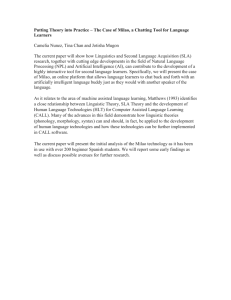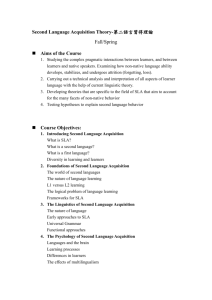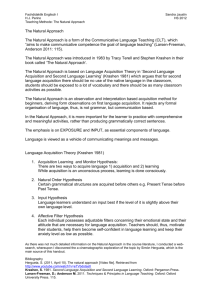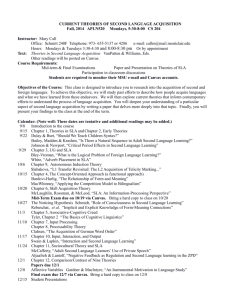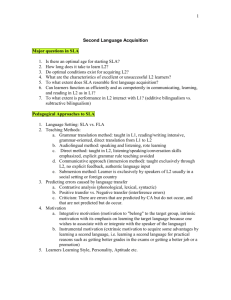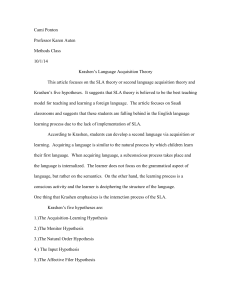ELTE-CETT Applied Linguistics Lecture X (ex
advertisement
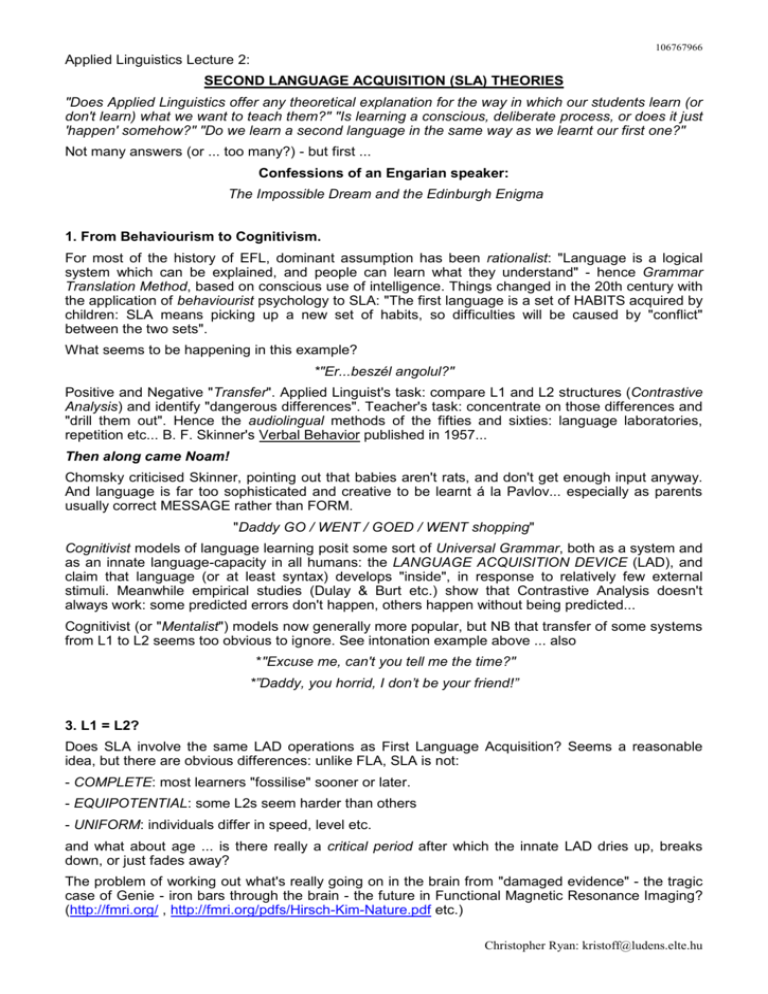
106767966 Applied Linguistics Lecture 2: SECOND LANGUAGE ACQUISITION (SLA) THEORIES "Does Applied Linguistics offer any theoretical explanation for the way in which our students learn (or don't learn) what we want to teach them?" "Is learning a conscious, deliberate process, or does it just 'happen' somehow?" "Do we learn a second language in the same way as we learnt our first one?" Not many answers (or ... too many?) - but first ... Confessions of an Engarian speaker: The Impossible Dream and the Edinburgh Enigma 1. From Behaviourism to Cognitivism. For most of the history of EFL, dominant assumption has been rationalist: "Language is a logical system which can be explained, and people can learn what they understand" - hence Grammar Translation Method, based on conscious use of intelligence. Things changed in the 20th century with the application of behaviourist psychology to SLA: "The first language is a set of HABITS acquired by children: SLA means picking up a new set of habits, so difficulties will be caused by "conflict" between the two sets". What seems to be happening in this example? *"Er...beszél angolul?" Positive and Negative "Transfer". Applied Linguist's task: compare L1 and L2 structures (Contrastive Analysis) and identify "dangerous differences". Teacher's task: concentrate on those differences and "drill them out". Hence the audiolingual methods of the fifties and sixties: language laboratories, repetition etc... B. F. Skinner's Verbal Behavior published in 1957... Then along came Noam! Chomsky criticised Skinner, pointing out that babies aren't rats, and don't get enough input anyway. And language is far too sophisticated and creative to be learnt á la Pavlov... especially as parents usually correct MESSAGE rather than FORM. "Daddy GO / WENT / GOED / WENT shopping" Cognitivist models of language learning posit some sort of Universal Grammar, both as a system and as an innate language-capacity in all humans: the LANGUAGE ACQUISITION DEVICE (LAD), and claim that language (or at least syntax) develops "inside", in response to relatively few external stimuli. Meanwhile empirical studies (Dulay & Burt etc.) show that Contrastive Analysis doesn't always work: some predicted errors don't happen, others happen without being predicted... Cognitivist (or "Mentalist") models now generally more popular, but NB that transfer of some systems from L1 to L2 seems too obvious to ignore. See intonation example above ... also *"Excuse me, can't you tell me the time?" *”Daddy, you horrid, I don’t be your friend!” 3. L1 = L2? Does SLA involve the same LAD operations as First Language Acquisition? Seems a reasonable idea, but there are obvious differences: unlike FLA, SLA is not: - COMPLETE: most learners "fossilise" sooner or later. - EQUIPOTENTIAL: some L2s seem harder than others - UNIFORM: individuals differ in speed, level etc. and what about age ... is there really a critical period after which the innate LAD dries up, breaks down, or just fades away? The problem of working out what's really going on in the brain from "damaged evidence" - the tragic case of Genie - iron bars through the brain - the future in Functional Magnetic Resonance Imaging? (http://fmri.org/ , http://fmri.org/pdfs/Hirsch-Kim-Nature.pdf etc.) Christopher Ryan: kristoff@ludens.elte.hu 4. Krashen's Input Hypothesis: the "Monitor Model" Even if SLA is not exactly the same as FLA, there do seem to be "universal similarities" (possibly even some sort of "natural order of acquisition"), associated with the "LAD". Neither "Conscious-Useof-the-Intelligence in directed study" nor "Pattern-Practice-and-Drilling for habit-formation" seems to explain how a second language is actually acquired. Stephen Krashen offers an attractive (if controversial) model: Affective Filter INPUT x x ONI x x x x x x M v v TOR x x L.A.D v xxxx v v v v v v i+1>>>>>>>> v xx> x> > > > v v v v v x x xxx =>=>=>=>OUTPUT=>=>=> ACQUISITION (unconscious; meaning-focused) as distinct from LEARNING (conscious; formfocused) NATURAL ORDER of acquisition via original "LAD"; (no "critical period"); COMPREHENSIBLE INPUT just above learner's current level ("i+1") provides best data for LAD to digest; SILENT PERIOD provides time for processing. AFFECTIVE FILTER hinders input, created by fear, distaste etc; reduced by motivation, confidence etc. MONITOR created by conscious learning, used to check performance NB the "Non-interface position": can consciously learned knowledge become acquired knowledge can anything move from monitor "back" to LAD? Krashen says "no", but ... It's easy to criticise Krashen and his model "too simple" - and incapable of empirical proof ... only really deals with basic syntax - not lexis, discourse, pragmatics etc. - K's attempts to transfer model to SKILLS (e.g. writing) very unconvincing ... older approaches ("rationalist, conscious understanding" and "behaviourist, habit-formation") are still very relevant! very broad model - lots of space for individual variation in aptitude, motivation etc. ... other theories/models available - see Recommended Reading ... BUT ... Krashen's Monitor Model does often seem to work and is intuitively attractive ... 5. SO... WHAT DOES ALL ALL THIS MEAN FOR LANGUAGE TEACHERS? Provide plenty of input, but don't take all the credit...or the blame. Be patient with the "silent ones" and with "mistakes"... praise “healthy errors”. Don't neglect "Affective Factors": they are "part of the job", not a "special treat"... __________________________________________________________________ Recommended Reading: http://en.wikipedia.org/wiki/Second_language_acquisition Ellis, R. (1985) Seven Theories of SLA. Understanding second language acquisition. OUP (pp 25175) Corder, S.P. (1971) Idiosyncratic dialects and error analysis. IRAL IX/2 Krashen, S. (1987) Principles and practice in second language acquisition Prentice Hall (pp 57-79) Schachter, J. (1988) Second language acquisition and its relationship to universal Grammar. APPLIED LINGUISTICS IV
